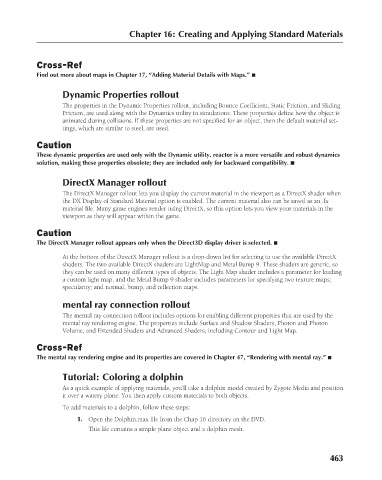Page 511 - Kitab3DsMax
P. 511
Chapter 16: Creating and Applying Standard Materials
Cross-Ref
Find out more about maps in Chapter 17, “Adding Material Details with Maps.” n
Dynamic Properties rollout
The properties in the Dynamic Properties rollout, including Bounce Coefficient, Static Friction, and Sliding
Friction, are used along with the Dynamics utility in simulations. These properties define how the object is
animated during collisions. If these properties are not specified for an object, then the default material set-
tings, which are similar to steel, are used.
Caution
These dynamic properties are used only with the Dynamic utility. reactor is a more versatile and robust dynamics
solution, making these properties obsolete; they are included only for backward compatibility. n
DirectX Manager rollout
The DirectX Manager rollout lets you display the current material in the viewport as a DirectX shader when
the DX Display of Standard Material option is enabled. The current material also can be saved as an .fx
material file. Many game engines render using DirectX, so this option lets you view your materials in the
viewport as they will appear within the game.
Caution
The DirectX Manager rollout appears only when the Direct3D display driver is selected. n
At the bottom of the DirectX Manager rollout is a drop-down list for selecting to use the available DirectX
shaders. The two available DirectX shaders are LightMap and Metal Bump 9. These shaders are generic, so
they can be used on many different types of objects. The Light Map shader includes a parameter for loading
a custom light map, and the Metal Bump 9 shader includes parameters for specifying two texture maps;
specularity; and normal, bump, and reflection maps.
mental ray connection rollout
The mental ray connection rollout includes options for enabling different properties that are used by the
mental ray rendering engine. The properties include Surface and Shadow Shaders, Photon and Photon
Volume, and Extended Shaders and Advanced Shaders, including Contour and Light Map.
Cross-Ref
The mental ray rendering engine and its properties are covered in Chapter 47, “Rendering with mental ray.” n
Tutorial: Coloring a dolphin
As a quick example of applying materials, you’ll take a dolphin model created by Zygote Media and position
it over a watery plane. You then apply custom materials to both objects.
To add materials to a dolphin, follow these steps:
1. Open the Dolphin.max file from the Chap 16 directory on the DVD.
This file contains a simple plane object and a dolphin mesh.
463
6/30/10 4:24 PM
24_617779-ch16.indd 463
24_617779-ch16.indd 463 6/30/10 4:24 PM

